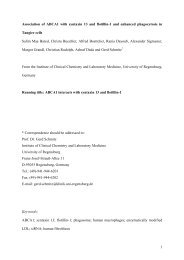SUNDAY, DECEMBER 4- Late Abstracts 1 - Molecular Biology of the ...
SUNDAY, DECEMBER 4- Late Abstracts 1 - Molecular Biology of the ...
SUNDAY, DECEMBER 4- Late Abstracts 1 - Molecular Biology of the ...
You also want an ePaper? Increase the reach of your titles
YUMPU automatically turns print PDFs into web optimized ePapers that Google loves.
<strong>SUNDAY</strong><br />
<strong>the</strong> SNARE protein Vamp-7. Lysosome secretion allows <strong>the</strong> extracellular release <strong>of</strong> proteases,<br />
whose activities promote <strong>the</strong> extraction <strong>of</strong> <strong>the</strong> immobilized Ag. We fur<strong>the</strong>r show that local reorganization<br />
<strong>of</strong> cortical actin by type I Myosins, which link <strong>the</strong> cortex to <strong>the</strong> plasma membrane,<br />
is required for lysosome exocytosis and Ag extraction. Remarkably, while <strong>the</strong> short-tail Myosin<br />
IC is recruited at <strong>the</strong> synapse and facilitates vesicle secretion and Ag uptake, <strong>the</strong> long-tail<br />
Myosin IE negatively regulates both processes. These results suggest that <strong>the</strong> two class I<br />
Myosins play antagonistic roles in <strong>the</strong> local reorganization <strong>of</strong> cortical actin for vesicle secretion<br />
and Ag uptake. The B cell synapse <strong>the</strong>refore emerges as a highly specialized site where tightly<br />
regulated exocytic and endocytic events take place thanks to <strong>the</strong> local shaping <strong>of</strong> <strong>the</strong><br />
membrane-cytoskeleton interface by class I Myosins<br />
1976<br />
Determination <strong>of</strong> <strong>the</strong> Subcellular, Surface, and Extracellular Localization <strong>of</strong> Hsp70s in<br />
Mammalian Cells.<br />
R. Medina* 1 , M. Rashedan* 1 , N. Nikolaidis 1 ; 1 Biological Science, California State University,<br />
Fullerton, Fullerton, CA<br />
70-kD Heat shock proteins (Hsp70s) are a family <strong>of</strong> molecular chaperones that play essential<br />
roles in stress response by promoting protein homeostasis. Members <strong>of</strong> this family are primarily<br />
localized in different subcellular compartments, including <strong>the</strong> cytosol, <strong>the</strong> endoplasmic reticulum,<br />
and <strong>the</strong> mitochondria. Apart from <strong>the</strong>ir primary location in specific parts <strong>of</strong> <strong>the</strong> cell, different<br />
Hsp70s have also been found in o<strong>the</strong>r places within <strong>the</strong> cell, at <strong>the</strong> cellular membrane, and at<br />
<strong>the</strong> extracellular milieu. Although a few stresses and pathophysiological conditions, like cancer,<br />
have been related with <strong>the</strong> re-localization <strong>of</strong> Hsp70s within <strong>the</strong> cell, <strong>the</strong>ir translocation to <strong>the</strong><br />
membrane, and <strong>the</strong>ir secretion from viable cells, <strong>the</strong> majority <strong>of</strong> <strong>the</strong>se conditions remain<br />
unknown. Additionally, <strong>the</strong> signaling mechanisms involved in <strong>the</strong> trafficking <strong>of</strong> intracellular<br />
Hsp70s remain elusive. To this end we studied <strong>the</strong> intra-, membrane- and extra-cellular<br />
localization <strong>of</strong> four members <strong>of</strong> <strong>the</strong> Hsp70 family. Specifically, we determined <strong>the</strong> re-localization<br />
<strong>of</strong> HSPA1A and HSPA8, primarily localized in <strong>the</strong> cytosol, HSPA5, primarily localized in <strong>the</strong><br />
endoplasmic reticulum, and HSPA9, primarily localized in <strong>the</strong> mitochondria. Human embryonic<br />
cells treated with different stressors, including heat and ethanol, or untreated were subjected to<br />
sub-cellular fractionation and <strong>the</strong> presence <strong>of</strong> Hsp70s was determined by Western. The amount<br />
<strong>of</strong> Hsp70s in <strong>the</strong> different fractions was quantified and normalized for equal loads using fractionspecific<br />
antibodies, e.g., beta-actin for <strong>the</strong> cytosolic fraction. These experiments revealed that<br />
under normal growth conditions all four proteins were present in <strong>the</strong> nuclear, cytosolic,<br />
mitochondrial, and membrane fractions, as well as in <strong>the</strong> extracellular medium. In heat-shocked<br />
cells, although all proteins were still present in all fractions <strong>the</strong>ir amounts in each fraction were<br />
significantly different from <strong>the</strong> untreated cells. These results strongly suggest that after stress<br />
<strong>the</strong> different Hsp70s are being re-localized within <strong>the</strong> cell, are anchored at <strong>the</strong> cellular<br />
membrane, and are secreted from <strong>the</strong> cell. Additional experiments using pharmacological<br />
manipulation <strong>of</strong> intracellular trafficking pathways are currently being performed to identify <strong>the</strong><br />
molecular mechanism used by Hsp70s to achieve <strong>the</strong>ir translocation and subsequent secretion.<br />
This study is <strong>the</strong> first step towards elucidating <strong>the</strong> biological importance <strong>of</strong> <strong>the</strong> relocalization and<br />
membrane occurrence <strong>of</strong> <strong>the</strong>se chaperones.<br />
*equal contribution
















